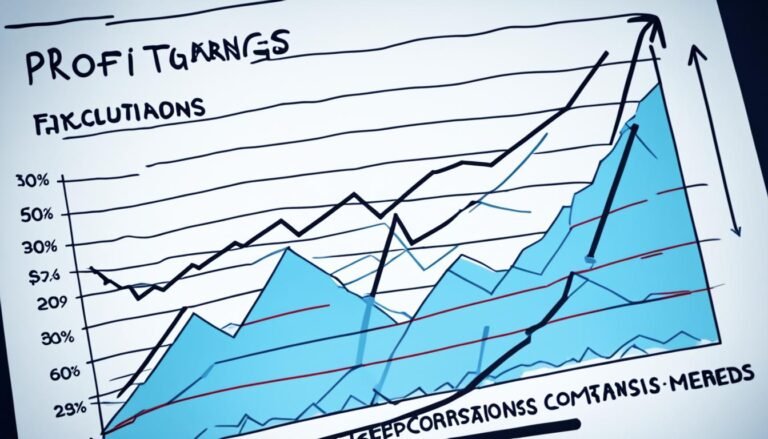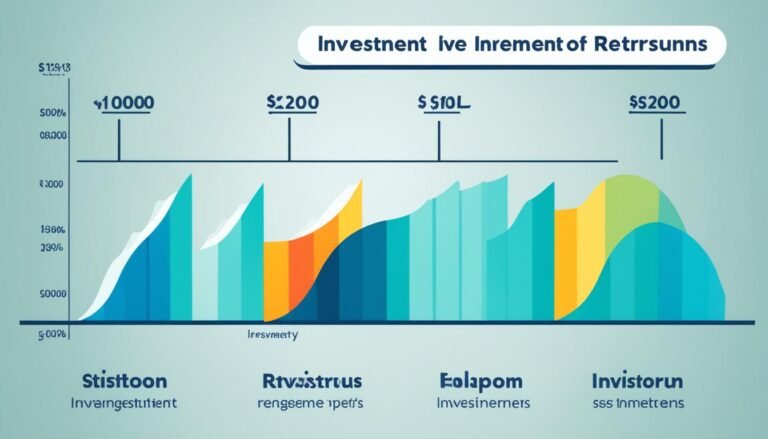Cost of Capital Calculation and Implications
Welcome to our comprehensive guide on the cost of capital calculation and its implications in financial decision making. Determining the cost of capital is an essential aspect of evaluating investment opportunities and making informed choices. By accurately assessing the cost of capital, businesses and investors can effectively analyze the viability and profitability of potential projects. In this article, we will explore the components of the cost of capital, the methods used to calculate it, and its significance in shaping financial strategies.
Key Takeaways:
- Accurately determining the cost of capital is crucial for financial decision making and investment evaluation.
- The cost of capital consists of the cost of equity and the cost of debt, which can be calculated using specific formulas.
- Calculating the weighted average cost of capital (WACC) takes into account the proportion of equity and debt in a company’s capital structure.
- The cost of capital serves as a benchmark for evaluating investment projects, determining the discount rate, and making informed financial decisions.
- An understanding of the cost of capital can shape financial strategies and impact the feasibility and risk assessment of investment opportunities.
Understanding the Cost of Capital
When it comes to financial decision making, understanding the cost of capital is crucial. This section will delve into the components of cost of capital, particularly the cost of equity and cost of debt. We will explore the formulas used to calculate these components and explore the various methods to determine the weighted average cost of capital (WACC).
Cost of Equity Formula
The cost of equity represents the return required by investors to hold a company’s stock. One commonly used formula to calculate the cost of equity is the dividend discount model (DDM). The DDM takes into account the expected dividends and the required rate of return to estimate the cost of equity.
WACC Calculation Methods
The weighted average cost of capital (WACC) considers both the cost of equity and the cost of debt, as well as the capital structure of a company. Several methods are employed to determine the WACC, including the traditional approach and the adjusted approach.
The traditional approach to calculating WACC assigns weights to the cost of equity and cost of debt based on the company’s capital structure. The formula is as follows: WACC = (E/V) * Re + (D/V) * Rd * (1 – Tax Rate), where E represents equity, V is the total value of the firm, Re is the cost of equity, D represents debt, Rd is the cost of debt, and the tax rate accounts for tax advantages of debt.
An alternative method is the adjusted approach, which takes into consideration the riskiness of the assets being financed. This approach involves determining the equity beta, unleveraging the beta, and then releveraging it with the company’s capital structure to calculate the WACC.
Understanding the cost of capital, including the cost of equity formula and the various WACC calculation methods, allows businesses and investors to make informed financial decisions. By accurately assessing the cost of capital, they can evaluate investment opportunities, determine appropriate discount rates, and optimize their capital structures.
| Component | Formula |
|---|---|
| Cost of Equity | Dividend Discount Model (DDM) |
| Weighted Average Cost of Capital (WACC) | Traditional Approach and Adjusted Approach |
Next, we will explore the significance of accurate cost of capital calculation and the implications it has on financial decision making.
Significance of Cost of Capital Calculation
In the realm of financial decision making, accurately determining the cost of capital holds immense importance. It serves as a crucial benchmark for evaluating investment projects, determining the discount rate, and making informed financial decisions.
The cost of capital is the rate of return required for capital invested in an asset or project to generate a desired return for investors. By calculating the cost of capital, businesses can assess the profitability and feasibility of potential investments, enabling them to make informed choices about resource allocation and investment opportunities.
One of the primary applications of cost of capital calculation is in determining the discount rate. The discount rate is used to calculate the present value of future cash flows, taking into account the time value of money. Accurately estimating the cost of capital ensures that the discount rate applied to investment analysis is appropriately aligned with the risk and return expectations of the project.
Furthermore, the cost of capital serves as a yardstick for evaluating the performance of investment projects. By comparing the expected return on a project to the cost of capital, businesses can gauge the viability and desirability of the investment. This evaluation helps in prioritizing investment opportunities and allocating resources efficiently.
Another important aspect is the role of the cost of capital in capital budgeting decisions. Capital budgeting involves analyzing and selecting investment projects that align with a company’s strategic objectives. Accurate cost of capital calculation enables businesses to make optimal decisions about capital budgeting, ensuring that investments align with the company’s risk appetite and return expectations.
Additionally, the cost of capital is a key factor in determining the capital structure of a company. It influences the mix of equity and debt financing utilized by businesses. By comprehensively evaluating the cost of capital, companies can make strategic financing decisions that maximize shareholder value and minimize the cost of capital.
Quote:
“Understanding and accurately calculating the cost of capital is essential for sound financial decision making. It provides a foundation for evaluating investments, determining discount rates, and shaping financial strategies.”
By recognizing the significance of cost of capital calculation, businesses can make informed financial decisions and optimize their investment choices. Having a clear understanding of the cost of capital empowers companies to allocate resources effectively, evaluate investments accurately, and navigate the complex landscape of financial decision making with confidence.
| Implications of Cost of Capital Calculation: |
|---|
| 1. Evaluation of investment projects |
| 2. Determining the discount rate |
| 3. Capital budgeting decisions |
| 4. Optimizing capital structure |
With a clear understanding of the implications of cost of capital calculation, businesses can navigate the complexities of financial decision making and make informed choices that drive long-term success and growth.
Calculating the Cost of Debt
When determining the cost of capital, it is crucial to accurately calculate the cost of debt. This involves considering various factors such as interest rates, taxes, and other relevant variables. Let’s delve into the intricacies of cost of debt calculation and explore its implications in determining the appropriate discount rate for investment evaluation.
One of the key components of the cost of debt calculation is the interest rate paid by the company on its debt. This rate reflects the cost the company incurs for borrowing capital. It is essential to consider both the stated interest rate and the effective interest rate, which takes into account any additional fees or costs associated with the debt. By accurately determining the interest rate, businesses can obtain a more precise measure of their cost of debt.
Taxes and the Cost of Debt
Another crucial consideration in the cost of debt calculation is the impact of taxes. The interest expenses incurred by a company are typically tax-deductible, resulting in a tax shield. This tax shield reduces the actual cost of debt for the business, effectively lowering the overall cost of capital.
“Calculating the cost of debt requires careful analysis of both the interest rate and the tax implications. By considering these factors, businesses can arrive at a more accurate estimate of their cost of debt and determine the appropriate discount rate for investment evaluation,”
In addition to interest rates and taxes, it is essential to consider other relevant factors that may affect the cost of debt. These factors could include credit ratings, market conditions, and the company’s financial health. By taking these variables into account, businesses can gain a comprehensive understanding of their cost of debt and its implications for investment decision-making.
Calculating the Cost of Equity
When it comes to determining the discount rate for investment analysis, understanding the cost of equity is crucial. The cost of equity represents the return required by investors to compensate for the risk they undertake by investing in a company’s stock.
There are different models to calculate the cost of equity, including the dividend discount model (DDM) and the capital asset pricing model (CAPM).
The **dividend discount model** calculates the cost of equity by estimating the present value of future dividends expected to be paid to shareholders. This model assumes that the value of a stock is directly correlated with the dividends it pays over time.
The **capital asset pricing model** determines the cost of equity by considering the company’s beta (systematic risk), the risk-free rate of return, and the market risk premium. It calculates the expected return on the stock based on the stock’s sensitivity to market movements.
Both models have their advantages and limitations. The DDM is more suitable for mature companies that consistently pay dividends, while the CAPM is widely used for companies with publicly traded stocks.
It’s important to note that the cost of equity is an essential factor in determining the discount rate applied to future cash flows. By accurately calculating the cost of equity, investors can make informed decisions about the feasibility and profitability of potential investments.
The Importance of Determining the Discount Rate
The discount rate is used in discounted cash flow (DCF) analysis to calculate the present value of future cash flows from an investment. It enables investors to compare the value of potential investments with different risk profiles and time horizons.
Determining the appropriate discount rate is crucial in accurately assessing the attractiveness of an investment opportunity. A higher discount rate implies a higher level of risk associated with the investment, resulting in a lower present value of future cash flows. Conversely, a lower discount rate signifies a lower level of risk and a higher present value.
By incorporating the cost of equity within the discount rate, investors can account for the specific risks associated with equity investments. This ensures that the investment analysis accurately reflects the required return by shareholders to compensate for their risk exposure.
| Risks Considered | Model Used |
|---|---|
| Consistent Dividend Payments | Dividend Discount Model (DDM) |
| Publicly Traded Stock | Capital Asset Pricing Model (CAPM) |
Overall, understanding and calculating the cost of equity is fundamental in determining the discount rate applied to investment analysis. It allows investors to make informed decisions based on risk-adjusted expected returns, ensuring that opportunities are assessed accurately and thoroughly.
Weighted Average Cost of Capital (WACC)
In the world of finance, the determination of the weighted average cost of capital (WACC) plays a crucial role in evaluating investment opportunities. WACC is a metric that takes into account the proportion of equity and debt in a company’s capital structure to provide a comprehensive view of the cost of funding.
By incorporating both equity and debt, WACC provides a holistic measure of the average rate of return required by investors to compensate for the risk associated with investing in a particular company. It serves as a benchmark for determining the discount rate and evaluating the feasibility of investment projects.
The calculation of WACC involves assigning weights to the cost of equity and the cost of debt based on their respective proportions in the capital structure. The cost of equity represents the return expected by shareholders, while the cost of debt represents the cost of borrowing for the company. The weights assigned to each component reflect their relative importance in funding the company’s operations.
Once the cost of equity and the cost of debt are determined, they are multiplied by their respective weights and summed to arrive at the overall WACC. This weighted average cost of capital is then used as the discount rate in project evaluation and capital budgeting decisions.
Let’s take a closer look at how the WACC formula is calculated:
WACC = (E/V) x Ke + (D/V) x Kd x (1 – Tc)
Where:
- E: Cost of equity
- V: Total value of the company (equity + debt)
- Ke: Cost of equity
- D: Cost of debt
- Kd: Cost of debt
- Tc: Tax rate
The WACC formula incorporates the tax rate to account for the tax shield provided by the deductibility of interest payments on debt. By considering the tax benefits, it provides a more accurate estimate of the true cost of capital.
Understanding and calculating the WACC is essential for businesses and investors as it allows them to evaluate investment opportunities and make informed financial decisions. By determining the appropriate discount rate through WACC calculation, companies can assess the viability of projects and allocate resources efficiently.
| Pros of WACC | Cons of WACC |
|---|---|
| Provides a comprehensive measure of the cost of capital | Relies on assumptions and estimates |
| Takes into account the company’s capital structure | Requires accurate input data |
| Facilitates comparison of investment opportunities | Does not account for market fluctuations |
While the WACC has its limitations and assumptions, it remains a valuable tool for decision-makers in evaluating projects and determining the appropriate discount rate. Using WACC as a guiding metric enables businesses to make well-informed financial decisions that align with their long-term goals.
Example: Calculating WACC
To better understand the calculation of WACC, let’s consider the following hypothetical scenario:
Company XYZ has a capital structure consisting of 70% equity and 30% debt. The cost of equity is estimated to be 10%, and the cost of debt is 5%. The tax rate is 25%. Let’s calculate the WACC for Company XYZ:
- Calculate the weighted cost of equity:
(70% x 10%) = 7% - Calculate the weighted cost of debt:
(30% x 5%) = 1.5% - Calculate the WACC:
(7% + 1.5% x (1 – 0.25) = 7.125%
In this example, the WACC for Company XYZ is determined to be 7.125%. This means that an investment opportunity must generate a return of at least 7.125% to be considered financially acceptable and in line with the company’s cost of capital.
Implications of Cost of Capital on Investment Decisions
Understanding the implications of the cost of capital on investment decisions is crucial for effective financial decision making. The cost of capital calculation plays a critical role in evaluating the profitability, risk assessment, and overall viability of potential investments.
When analyzing different cost of capital scenarios, businesses and investors can gain valuable insights into the financial impact on their investment choices. By accurately determining the cost of capital, they can make informed decisions that align with their strategic goals and maximize returns.
Profitability
The cost of capital has a direct impact on the profitability of investment projects. It serves as a benchmark for evaluating whether the expected return on an investment exceeds the cost of capital. By comparing the expected return with the cost of capital, businesses can identify projects that generate positive net present value, indicating a profitable investment opportunity.
Furthermore, understanding the relationship between cost of capital and profitability allows businesses to prioritize investments with higher expected returns. By allocating resources to projects that are expected to generate the highest profitability, businesses can optimize their capital allocation and enhance overall financial performance.
Risk Assessment
The cost of capital calculation also aids in risk assessment. It provides insights into the required rate of return to compensate investors for the level of risk associated with an investment. Investments with higher perceived risk will have a higher cost of capital, reflecting the additional return required to compensate for the increased risk.
By considering the implications of the cost of capital on risk assessment, businesses can make more informed decisions regarding their risk appetite. They can evaluate investments based on their risk-return profiles and align their investment decisions with their risk management strategies.
Viability of Investments
Accurately calculating the cost of capital ensures the evaluation of the viability of potential investments. It enables businesses to assess whether the internal rate of return (IRR) of an investment exceeds the cost of capital. Investments with an IRR higher than the cost of capital are considered viable, indicating the potential for positive returns.
Understanding the implications of the cost of capital on investment viability allows businesses to prioritize investments that align with their long-term growth objectives. By focusing on viable investments, businesses can enhance their competitive advantage and drive sustainable financial success.
| Cost of Capital Scenarios | Profitability | Risk Assessment | Viability of Investments |
|---|---|---|---|
| High Cost of Capital | Lower profitability | Higher risk | Lower investment viability |
| Low Cost of Capital | Higher profitability | Lower risk | Higher investment viability |
Financial Strategies and Cost of Capital
Capital Allocation and Investment Decisions
Understanding the cost of capital is essential for businesses and investors to make informed financial decisions. The cost of capital determines the minimum return required for an investment to be deemed profitable and helps assess the risk associated with potential projects.
When considering capital allocation and investment decisions, it is crucial to weigh the impact of the cost of capital on the expected returns. A higher cost of capital implies a higher hurdle rate, making it more challenging for investments to meet the required financial targets.
By accurately determining the cost of capital, businesses can establish appropriate discount rates that reflect the level of risk associated with their investment opportunities. This enables them to identify projects that align with their financial goals and risk tolerance.
Optimal Capital Structure for Financial Success
Another important consideration when it comes to financial strategies is determining the optimal capital structure. This refers to the proportion of debt and equity in a company’s financing mix.
The cost of capital plays a significant role in establishing the optimal capital structure. A company’s cost of debt and cost of equity influence the relative weighting of these financing components. Finding the right balance between debt and equity can have a substantial impact on a company’s overall cost of capital.
Furthermore, understanding the cost of capital helps determine the available financing options for businesses. It enables them to assess the feasibility of raising funds through debt issuance or equity offerings, considering both the financial implications and the impact on their capital structure.
Strategic Planning and Long-Term Growth
Effective cost of capital analysis is a valuable tool for strategic planning and long-term growth. By examining the cost of capital across different investment opportunities, businesses can strategically allocate resources to the most profitable projects.
Moreover, understanding the cost of capital aids in evaluating potential acquisition targets or expansion plans. It enables businesses to assess the financial attractiveness of such ventures, considering the impact on their cost of capital and the projected returns.
“An accurate understanding of the cost of capital is integral to making sound financial decisions and formulating effective strategies for growth.”
By integrating the cost of capital into financial strategies, businesses and investors can optimize decision-making, improve profitability, and mitigate risk. It provides a comprehensive framework for evaluating investment opportunities, establishing appropriate discount rates, and optimizing capital structures.
Conclusion
Throughout this article, we have explored the concept of cost of capital calculation and its implications. We have emphasized the importance of accurately determining the cost of capital for smarter financial strategies and informed investment decisions.
By understanding the cost of capital, businesses and investors can assess the feasibility of investment opportunities and make sound financial choices. The cost of capital serves as a benchmark for evaluating investment projects and determining the appropriate discount rate, taking into account both the cost of equity and the cost of debt.
Moreover, the cost of capital plays a crucial role in shaping financial strategies, as it influences capital structure decisions and risk assessment. A comprehensive understanding of the cost of capital enables businesses to optimize their capital mix and maximize shareholder value.
In conclusion, the accurate calculation of the cost of capital has far-reaching implications in financial decision making. By considering the cost of capital in investment analysis, businesses and investors can mitigate risk, enhance profitability, and pave the way for long-term success.
FAQ
What is the cost of capital calculation, and what are its implications?
The cost of capital calculation refers to the process of determining the required return on a company’s investments. It takes into account the cost of equity, cost of debt, and the proportion of each in the company’s capital structure. The implications of accurate cost of capital calculation are significant, as it serves as a benchmark for evaluating investment projects, determining the discount rate, and making informed financial decisions.
Can you explain how to calculate the cost of equity and the weighted average cost of capital (WACC)?
The cost of equity can be calculated using various models, such as the dividend discount model (DDM) or the capital asset pricing model (CAPM). The WACC is determined by weighting the cost of equity and the cost of debt based on the proportion of each in the company’s capital structure. It is crucial to consider these calculations when assessing the feasibility of investment opportunities.
Why is accurately calculating the cost of capital important?
Accurately calculating the cost of capital is essential because it provides a benchmark for evaluating investment projects. It helps businesses determine the discount rate, which affects the present value of future cash flows. Additionally, it enables companies to make informed financial decisions regarding capital allocation, debt financing, and potential mergers and acquisitions.
How is the cost of debt calculated, and what role does it play in investment evaluation?
The cost of debt considers the interest rate, taxes, and any other expenses associated with borrowing. By calculating the cost of debt, businesses can determine the appropriate discount rate for investment evaluation. This rate reflects the return required by debt holders and affects the viability of investment opportunities.
What are the formulas used to calculate the cost of equity?
The cost of equity can be calculated using different models, such as the dividend discount model (DDM), which considers the expected future dividends, or the capital asset pricing model (CAPM), which takes into account the risk-free rate, market risk premium, and the company’s beta. These formulas provide insights into the required return on equity investments.
How does the weighted average cost of capital (WACC) affect investment decisions?
The weighted average cost of capital (WACC) is a crucial factor in investment decisions. It reflects the company’s overall cost of capital by considering the relative proportions of equity and debt in its capital structure. The WACC plays a significant role in determining the feasibility and profitability of potential investments.
What are the implications of the cost of capital on investment decisions?
The cost of capital has several implications for investment decisions. It affects the profitability and risk assessment of potential investments. Higher cost of capital can lead to higher discount rates, reducing the present value of future cash flows. It also influences the capital allocation decisions and the overall financial viability of investment opportunities.
How does the cost of capital impact financial strategies and decision making?
The cost of capital plays a crucial role in financial strategies and decision making. It helps businesses determine the optimal capital structure by balancing equity and debt financing. It provides insights into the risk and return trade-off, influencing decisions related to mergers, acquisitions, and long-term investments. Understanding the cost of capital allows businesses to make sound financial decisions aligned with their objectives.
In conclusion, what are the key points regarding cost of capital calculation and its implications?
Accurately calculating the cost of capital is crucial for financial decision making. It serves as a benchmark to evaluate investment projects and determine the discount rate for future cash flows. Understanding the cost of equity and debt, as well as the weighted average cost of capital (WACC), enables businesses to make informed choices about capital allocation and long-term investments. The implications of the cost of capital impact profitability, risk assessment, and overall financial viability of investment opportunities.








